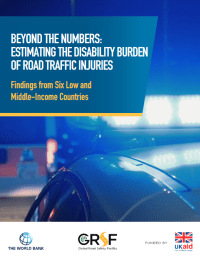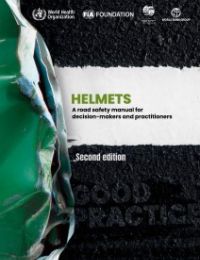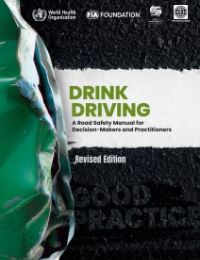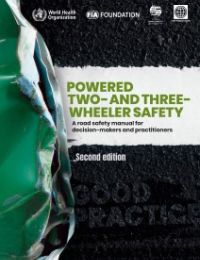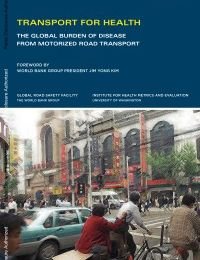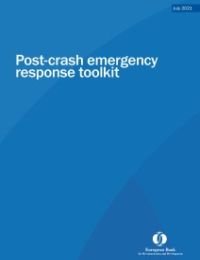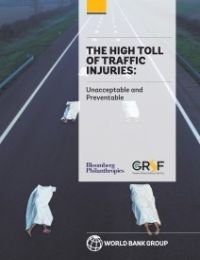Publications
1-9 of 9
-
Post-Crash Health Care
Beyond the Numbers: Estimating the Disability Burden of Road Traffic Injuries
November 2023
-
-
Road Users
Drink-Driving: A Road Safety Manual for Decision-Makers and Practitioners (2nd ed.)
November 2022
-
Post-Crash Health Care
Transport for Health: The Global Burden of Disease from Motorized Road Transport
August 2021
-
- reasons for taking action
- the main elements of post-crash response
- examples of best practice
- helpful resources.
- government departments and policymakers
- local and regional government
- emergency service managers and professionals
- paramedics and community responders
- laypeople and members of the community
- crash survivors, families, and organizations representing them.
-
-
-
Cutting traffic deaths and injuries by half could add 7 to 22% to GDP per capita over 24 years in select countries
-
Welfare benefits equivalent to 6 to 32% of GDP per capita could be realized over the same period if traffic deaths and injuries were halved
-
Road traffic injuries are the single largest cause of mortality and long-term disability among people aged 15-29, prime working age
-
Reducing the number of RTIs leads to long-term national income growth. This correlation is easy to establish as RTIs are the single largest cause of mortality and long-term disability among young people aged 15-29 (prime working age).
-
Significant long-term income growth—7 to 22% increase in GDP per capita over 24 years—can be achieved by halving road traffic deaths and injuries, in line with the current UN targets.
-
The study goes beyond productivity or economic gains, and highlights the broader welfare benefits associated with reducing road traffic mortality and morbidity, adding years of life free of injuries and lasting disabilities. This recognizes that GDP is an imperfect measure of social welfare, as it does not factor health benefits. The study finds welfare benefits equivalent to 6 to 32% of the national GDP can be realized from reducing road deaths and injuries by 50% over 24 years.
-
By maximizing healthy years of life, free of injuries and disabilities, actions to reduce road traffic injuries can help countries increase productivity, enhance the well-being of their populations, and build human capital—a key developmental priority for the World Bank.
-
Road safety goes beyond the transport sector, with a direct impact on public health, societies, and economies. Likewise, because road safety is an inherently cross-sectoral issue, real progress can only happen if all relevant stakeholders unite their efforts.
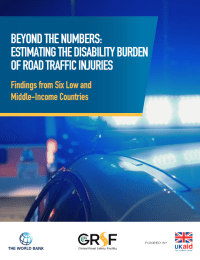
It is well-documented that road crashes claim around 1.35 million lives each year and rank as the eighth leading cause of death globally, causing huge burdens for economies, health systems, and transport networks. However, beneath the sobering fatality statistics lies a largely unexplored landscape: the staggering toll of disabilities induced by road crashes. Until now, the focus of road safety research and policy discourse has predominantly revolved around fatalities, which has limited our understanding of traffic-related injuries and disability burdens at the individual, community, and national level.
To address this critical knowledge gap, this pioneering study—involving over 2,300 patients hospitalized for road crash injuries—provides valuable insights into the prevalence, causes, and long-term impacts of crash-related disabilities. By broadening the discussion beyond fatalities to the often-overlooked issue of disability, the report paves the way for a more holistic perspective on road safety impacts, which can inform more effective road safety policies.
This report is a call to action for comprehensive and context-specific interventions that encompass both the transport and health sectors. Effective measures may include implementing safety regulations, enhancing emergency services, strengthening rehabilitative care, and expanding social safety nets to ease the financial burden on crash survivors. Collaborative efforts between governments, global and regional organizations, civil society, and other stakeholders will be indispensable.
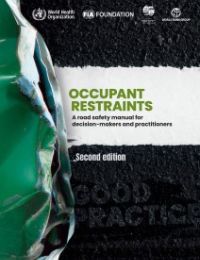
This manual provides guidance and evidence for decision-makers and practitioners that should lead to an increase in the use of vehicle occupant restraints, such as seat-belts for adults and car seats for babies and children. It draws on experience from countries that have succeeded in achieving and sustaining high levels of vehicle occupant restraint use, and builds on new evidence, including from low and middle-income countries.
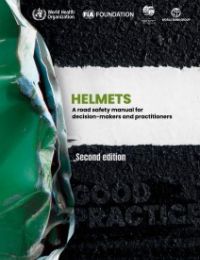
Safe, quality helmets reduce the risk of death in a road crash by over six times, and reduce the risk of brain injury by up to 74%. Head trauma is the leading cause of death for riders, and motorcycles continue to proliferate rapidly. Yet the use of helmets in many low and middle-income countries remains low.
The second edition of the Helmets Manual offers guidance to help decision makers and practitioners put in place the comprehensive set of laws, regulations and actions needed to increase the use of safe, quality helmets to save lives.
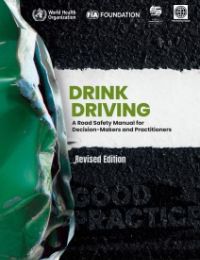
This manual provides guidance for decision-makers and practitioners to reduce the prevalence of drink driving and associated road trauma. It draws on experience from countries that have succeeded in achieving and sustaining reductions in alcohol-related road trauma, and includes recommendations for developing and implementing drink driving legislation, and advice on how to monitor and evaluate progress.
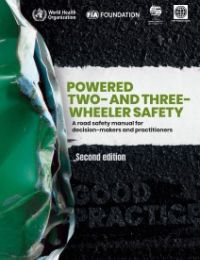
Nearly 30% of all road traffic deaths reported to WHO involve powered two- and three-wheeled vehicles, such as motorcycles, mopeds, scooters and electrical bikes (e-bikes). As these vehicles become increasingly widespread, particularly in low-and middle-income countries, the proportion of deaths involving them is increasing.
The second edition of the Powered- Two and Three-Wheeler Safety Manual offers guidance to help decision makers and practitioners put in place the comprehensive set of laws, regulations and actions needed to save lives. Rooted in new case studies and evidence, including from low- and middle-income countries, it includes guidelines on developing safer roads, ensuring safer mobility for all road users, vehicle safety standards, and actions to improve emergency responses to crashes.

This report summarizes the findings of a long and meticulous journey of data gathering and analysis to quantify the health losses from road deaths and injuries worldwide, as part of the path-finding Global Burden of Disease (GBD) study. It is important, first, to acknowledge the profound contribution made by the lead authors and global team of injury prevention professionals to estimate the disease burden of road trauma, before absorbing their findings and recommendations. Without their dedication and tenacity, the way forward would be less certain.
The first GBD study, published nearly two decades ago, signaled an emerging road safety crisis in developing regions of the world. It triggered a remarkable program of global advocacy that culminated in the United Nations decade of action for road safety and a global plan to bring road safety outcomes under control in these regions by 2020. However, limited investment has been mobilized so far to implement the UN initiative. The second GBD studies, and related analyses presented in this report, confirm the importance of road safety as a global development priority and the urgency with which it must be addressed.
The report's findings highlight the growth in road deaths and injuries globally, and their substantial impacts on maternal and child health, despite sustained reductions over the last three to four decades in high-income countries. Combined with the deaths arising from vehicle pollution, the road transport death toll exceeds that of, for example, HIV/AIDS, tuberculosis, malaria, or diabetes. This statistic further reinforces the call for global action. Without these GBD estimates, we would not have a clear picture of the true situation because official country data in the developing world vastly understate the scale of road transport health losses.
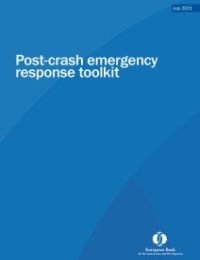
What is this toolkit?
This toolkit sets out the key elements of effective post-crash emergency response. The toolkit covers:
Who is this toolkit for?
The toolkit is for all stakeholders with an interest in post-crash response. This includes:
How to use it
The toolkit describes basic good practices for organizing an effective post-crash response. It is a starting point for dialogue and discussion, aimed at identifying goals for improving post-crash services. Every country has different structures and challenges, so the toolkit is not “one-size-fits-all.” However, certain elements of good post-crash response apply everywhere: the need for strategic planning and investment, good coordination, communication, equipment, and training.
To learn more about this project, click here.
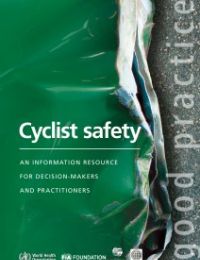
Cycling has many health and environmental benefits. Yet every year 41 000 cyclists die in road traffic-related crashes worldwide. Many leave their homes as they would on any normal day – for school, work, worship, or meeting friends – never to return. Millions more people are injured in road traffic-related crashes while cycling, some of whom become permanently disabled. These incidents cause much suffering and grief, as well as economic hardship for families and loved ones.
However, the growing focus on sustainable mobility – an increasing effort to shift more travel from motorized transport to the use of public transport, walking and cycling – makes cyclists’ safety an increasingly important component of road safety efforts. Cyclist collisions, like other road traffic crashes, are predictable and preventable and therefore should not be accepted as inevitable.
Cyclist safety: an information resource for decision-makers and practitioners describes the magnitude of cyclist death and injury, the key risk factors, and effective interventions. The document stresses the importance of a comprehensive, holistic approach that includes legislation, enforcement and behavioral measures specifically for cyclists; design of the built environment; as well as integrating cyclist safety into overall road safety and transport strategies. It also draws attention to the benefits of cycling, which should be promoted as an important mode of transport given its potential to improve health and preserve the environment.
We hope that this resource, which is designed for a multidisciplinary audience including engineers, planners, law enforcement officers, public health professionals and educators, will contribute towards strengthening national and local capacity to implement cyclist safety measures in various settings worldwide. We encourage all to bring this resource to the attention of those who will use it to save the lives of cyclists.
The World Health Organization (WHO) coordinated the production of this resource. Soames Job, Head GRSF and Global Lead Road Safety, World Bank was one of the principal writers of this document. GRSF contributions to this document were supported by UK Aid.
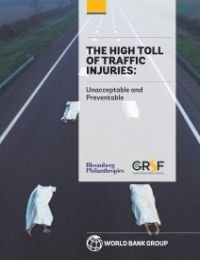
Key Findings ⌵︎
Each year, 1.25 million people lose their lives on the world’s roads and another 20 to 50 million are seriously injured. The tragic loss from a road traffic death or serious injury is compounded by the harm to households and social networks. A disproportionate 90% of road traffic injuries (RTIs) occur in low- and middle-income countries (LMICs), representing a major public health and economic burden. This is an eminently preventable problem that is critical to the development agenda. Unfortunately, due to lack of solid data, the impact of road injuries on economic growth and social welfare has been difficult to assess.
A new World Bank report funded by Bloomberg Philanthropies, The High Toll of Traffic Injuries: Unacceptable and Preventable, looks to fill the gap. It proposes a comprehensive methodology to quantify both the income growth and social welfare benefits that safer roads could bring to developing countries. The analysis is based on data collected from 135 countries over 24 years, and focuses on China, India, the Philippines, Tanzania, and Thailand—five geographically, demographically and economically diverse LMICs.
The study shows that reducing the number of RTIs in developing countries not only increases income growth, but also generates substantial welfare benefits to societies.
Key findings from the report include:
> Press Release: Road Deaths and Injuries Hold Back Economic Growth in Developing Countries

